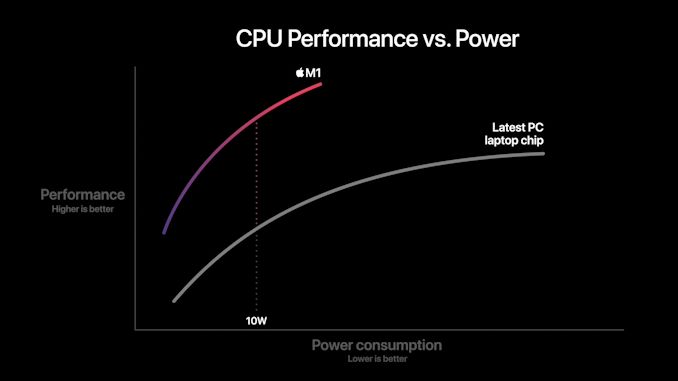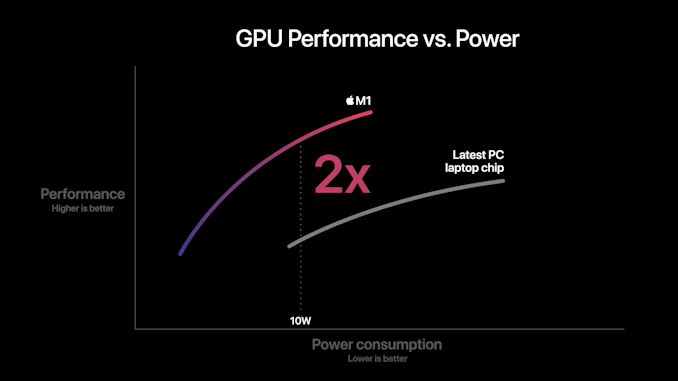Apple Announces The Apple Silicon M1: Ditching x86 - What to Expect, Based on A14
by Andrei Frumusanu on November 10, 2020 3:00 PM EST- Posted in
- Apple
- Apple A14
- Apple Silicon
- Apple M1
Apple Shooting for the Stars: x86 Incumbents Beware
The previous pages were written ahead of Apple officially announcing the new M1 chip. We already saw the A14 performing outstandingly and outperforming the best that Intel has to offer. The new M1 should perform notably above that.
We come back to a few of Apple’s slides during the presentations as to what to expect in terms of performance and efficiency. Particularly the performance/power curves are the most detail that Apple is sharing at this moment in time:
In this graphic, Apple showcases the new M1 chip featuring a CPU power consumption peak of around 18W. The competing PC laptop chip here is peaking at the 35-40W range so certainly these are not single-threaded performance figures, but rather whole-chip multi-threaded performance. We don’t know if this is comparing M1 to an AMD Renoir chip or an Intel ICL or TGL chip, but in both cases the same general verdict applies:
Apple’s usage of a significantly more advanced microarchitecture that offers significant IPC, enabling high performance at low core clocks, allows for significant power efficiency gains versus the incumbent x86 players. The graphic shows that at peak-to-peak, M1 offers around a 40% performance uplift compared to the existing competitive offering, all whilst doing it at 40% of the power consumption.
Apple’s comparison of random performance points is to be criticised, however the 10W measurement point where Apple claims 2.5x the performance does make some sense, as this is the nominal TDP of the chips used in the Intel-based MacBook Air. Again, it’s thanks to the power efficiency characteristics that Apple has been able to achieve in the mobile space that the M1 is promised to showcase such large gains – it certainly matches our A14 data.
Don't forget about the GPU
Today we mostly covered the CPU side of things as that’s where the unprecedented industry shift is happening. However, we shouldn’t forget about the GPU, as the new M1 represents Apple’s first-time introduction of their custom designs into the Mac space.
Apple’s performance and power efficiency claims here are really lacking context as we have no idea what their comparison point is. I won’t try to theorise here as there’s just too many variables at play, and we don’t know enough details.
What we do know is that in the mobile space, Apple is absolutely leading the pack in terms of performance and power efficiency. The last time we tested the A12Z the design was more than able to compete and beat integrated graphics designs. But since then we’ve seen more significant jumps from both AMD and Intel.
Performance Leadership?
Apple claims the M1 to be the fastest CPU in the world. Given our data on the A14, beating all of Intel’s designs, and just falling short of AMD’s newest Zen3 chips – a higher clocked Firestorm above 3GHz, the 50% larger L2 cache, and an unleashed TDP, we can certainly believe Apple and the M1 to be able to achieve that claim.
This moment has been brewing for years now, and the new Apple Silicon is both shocking, but also very much expected. In the coming weeks we’ll be trying to get our hands on the new hardware and verify Apple’s claims.
Intel has stagnated itself out of the market, and has lost a major customer today. AMD has shown lots of progress lately, however it’ll be incredibly hard to catch up to Apple’s power efficiency. If Apple’s performance trajectory continues at this pace, the x86 performance crown might never be regained.












644 Comments
View All Comments
SarahKerrigan - Tuesday, November 10, 2020 - link
Look at Anandtech's benchmarking in this very article. I'm sure you can find it if you look carefully.BlackHat - Tuesday, November 10, 2020 - link
Yes, I see the benchmarks, but that doesn't calm my concerns that if those numbers looks so good here why compare their chips against an SkyLake chip?michael2k - Tuesday, November 10, 2020 - link
Because they didn't pay Intel for any SkyLake chips?Essentially Intel's designs only improve by 10% per given generation, so given they've been stuck at 14nm and only have some 10nm parts, you might see a 10% or 15% improvement with the newest Intel parts.
A 10% or 15% improvement won't beat the M1
BlackHat - Tuesday, November 10, 2020 - link
What do you mean? Apple have Ice Lake MacBook that they could used to compare.valuearb - Tuesday, November 10, 2020 - link
Apple compared the M1 Macs vs. their exact predecessors, which is a 1.7 Ghz I7 in the case of the Mac Book Pro two port 13 inch.Note that the 13 inch Tiger Lake MBP had to be made thicker and heavier to accommodate Tiger Lake with adequate battery life.
Also that Anandtech's own benchmarks show Tiger Lake on par with the iPhone 12 A14 CPU, at four times the power usage.
name99 - Tuesday, November 10, 2020 - link
Give it a fscking rest. Go read Apple's web site:Testing conducted by Apple in October 2020 using preproduction MacBook Air systems with Apple M1 chip and 8-core GPU, as well as ***production 1.2GHz quad-core Intel Core i7-based MacBook Air systems***, all configured with 16GB RAM and 2TB SSD.
They tested against the currently shipping Mac equivalents. You want to test against your favorite laptop do it yourself, Apple doesn't owe you ever benchmark you can possibly imagine.
Apple tested against the competitor product as far as THEIR CUSTOMERS ARE CONCERNED. Everyone else in the world understands this, why can't you?
trixn86 - Wednesday, November 11, 2020 - link
Exactly this.They compared it to the competing device in their product line that most of their customers currently have in use. And those are also the customers that are most likely to consider to upgrade to a new device. Also 2.8x faster sounds better than 1.whatever x faster if they'd taken a best intel notebook cpu available whose users wouldn't want to upgrade anyways.Spunjji - Thursday, November 12, 2020 - link
Because it's like-for-like *within their product range*.Apple customers don't care about how fast it is when compared with somebody else's products.
Glaurung - Tuesday, November 10, 2020 - link
This article, that you seem to have not read, benchmarks the A14, in the latest iphone, against intel and AMD laptop/desktop chips.And the phone chip, with a 5w TDP, is as fast or faster than anything except the latest AMD desktop chip.
Given that there is no way the M1 is going to be *slower* than the chip in this years iphones, I think the article's conclusions are fair. And we'll have benchmarks of actual M1 macs to look at in another week or so.
BlackHat - Tuesday, November 10, 2020 - link
I'm just saying that if Apple didn't compare their chips against Ice Lake or even a more recent chip that give a lot of skepticism, Ice Lake is better than the Renoir in Spec but no so much in real word test, even those no multicore.